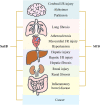Pharmacological Effects of Salvianolic Acid B Against Oxidative Damage
- PMID: 33343348
- PMCID: PMC7741185
- DOI: 10.3389/fphar.2020.572373
Pharmacological Effects of Salvianolic Acid B Against Oxidative Damage
Abstract
Salvianolic acid B (Sal B) is one of the main active ingredients of Salvia miltiorrhiza, with strong antioxidant effects. Recent findings have shown that Sal B has anti-inflammatory, anti-apoptotic, anti-fibrotic effects and can promote stem cell proliferation and differentiation, and has a beneficial effect on cardiovascular and cerebrovascular diseases, aging, and liver fibrosis. Reactive oxygen species (ROS) include oxygen free radicals and oxygen-containing non-free radicals. ROS can regulate cell proliferation, survival, death and differentiation to regulate inflammation, and immunity, while Sal B can scavenge oxygen free radicals by providing hydrogen atoms and reduce the production of oxygen free radicals and oxygen-containing non-radicals by regulating the expression of antioxidant enzymes. The many pharmacological effects of Sal B may be closely related to its elimination and inhibition of ROS generation, and Nuclear factor E2-related factor 2/Kelch-like ECH-related protein 1 may be the core link in its regulation of the expression of antioxidant enzyme to exert its antioxidant effect. What is confusing and interesting is that Sal B exhibits the opposite mechanisms in tumors. To clarify the specific target of Sal B and the correlation between its regulation of oxidative stress and energy metabolism homeostasis will help to further understand its role in different pathological conditions, and provide a scientific basis for its further clinical application and new drug development. Although Sal B has broad prospects in clinical application due to its extensive pharmacological effects, the low bioavailability is a serious obstacle to further improving its efficacy in vivo and promoting clinical application. Therefore, how to improve the availability of Sal B in vivo requires the joint efforts of many interdisciplinary subjects.
Keywords: Keap1; Nrf2; ROS; oxidative damage; salvianolic acid B.
Copyright © 2020 Xiao, Liu, Mu, Zhang, Wang, Zhao, Chen and Liu.
Figures





Similar articles
-
Salvianolic acid A protects RPE cells against oxidative stress through activation of Nrf2/HO-1 signaling.Free Radic Biol Med. 2014 Apr;69:219-28. doi: 10.1016/j.freeradbiomed.2014.01.025. Epub 2014 Jan 28. Free Radic Biol Med. 2014. PMID: 24486344
-
SALVIANOLIC ACID B ALLEVIATING MYOCARDIUM INJURY IN ISCHEMIA REPERFUSION RATS.Afr J Tradit Complement Altern Med. 2016 Jul 3;13(4):157-161. doi: 10.21010/ajtcam.v13i4.20. eCollection 2016. Afr J Tradit Complement Altern Med. 2016. PMID: 28852731 Free PMC article.
-
Salvianolic acid B inhibits low-density lipoprotein oxidation and neointimal hyperplasia in endothelium-denuded hypercholesterolaemic rabbits.J Sci Food Agric. 2011 Jan 15;91(1):134-41. doi: 10.1002/jsfa.4163. Epub 2010 Sep 7. J Sci Food Agric. 2011. PMID: 20824680
-
The Anti-Inflammatory and Anti-Oxidant Mechanisms of the Keap1/Nrf2/ARE Signaling Pathway in Chronic Diseases.Aging Dis. 2019 Jun 1;10(3):637-651. doi: 10.14336/AD.2018.0513. eCollection 2019 Jun. Aging Dis. 2019. PMID: 31165007 Free PMC article. Review.
-
Role of salvianolic acid B in the treatment of acute ischemic stroke: a systematic review and meta-analysis of animal models.Front Pharmacol. 2024 Dec 24;15:1479765. doi: 10.3389/fphar.2024.1479765. eCollection 2024. Front Pharmacol. 2024. PMID: 39776581 Free PMC article. Review.
Cited by
-
Targeting Oxidative Stress as a Therapeutic Approach for Idiopathic Pulmonary Fibrosis.Front Pharmacol. 2022 Jan 21;12:794997. doi: 10.3389/fphar.2021.794997. eCollection 2021. Front Pharmacol. 2022. PMID: 35126133 Free PMC article. Review.
-
Salvianolic acid B attenuates inflammation and prevent pathologic fibrosis by inhibiting CD36-mediated activation of the PI3K-Akt signaling pathway in frozen shoulder.Front Pharmacol. 2023 Aug 1;14:1230174. doi: 10.3389/fphar.2023.1230174. eCollection 2023. Front Pharmacol. 2023. PMID: 37593175 Free PMC article.
-
Role and molecular mechanism of Salvia miltiorrhiza associated with chemical compounds in the treatment of diabetes mellitus and its complications: A review.Medicine (Baltimore). 2024 Apr 19;103(16):e37844. doi: 10.1097/MD.0000000000037844. Medicine (Baltimore). 2024. PMID: 38640337 Free PMC article. Review.
-
Metabolic Reprograming of Macrophages: A New Direction in Traditional Chinese Medicine for Treating Liver Failure.J Immunol Res. 2024 Dec 24;2024:5891381. doi: 10.1155/jimr/5891381. eCollection 2024. J Immunol Res. 2024. PMID: 39741958 Free PMC article. Review.
-
Preclinical and experimental evidence of salvianolic acid B in the treatment of neurological diseases.Front Pharmacol. 2025 Jun 27;16:1606146. doi: 10.3389/fphar.2025.1606146. eCollection 2025. Front Pharmacol. 2025. PMID: 40657643 Free PMC article. Review.
References
-
- Ba J., Peng H., Chen Y., Gao Y. (2014). Effects and mechanism analysis of vascular endothelial growth factor and salvianolic acid B on 125I-low density lipoprotein permeability of the rabbit aortary endothelial cells. Cell Biochem. Biophys. 70 (3), 1533–1538. 10.1007/s12013-014-0089-z - DOI - PubMed
Publication types
LinkOut - more resources
Full Text Sources
Research Materials

